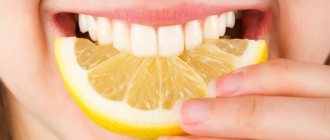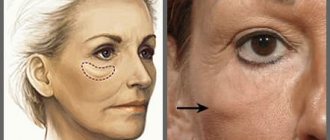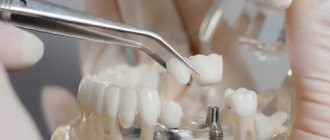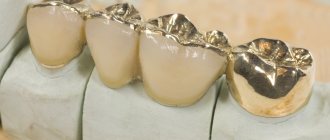Restoring a damaged tooth is a complex work aimed at preserving your dental unit and avoiding prosthetics or implantation. Modern dentistry offers a number of effective methods for treating a damaged tooth, even if only a two-millimeter root remains. In this material we will give answers to the most common questions regarding how to reliably restore a dental unit if it is more than half destroyed.
What teeth can be restored?
In dental practice, it is customary to consider those crowns that are missing more than 50% of their parts as a result of:
- carious lesion;
- mechanical injury;
- the presence of old fillings that do not collapse on their own, but caries develops underneath them;
- depulpation, against which the crown becomes fragile and changes color;
- increased abrasion of dentin, etc.
If you do not seek help from a dentist in time, restoring the unit will be problematic.
Why does tooth loss occur?
Until the 18th century, there was a theory in the world about a worm that ate teeth, destroying them and causing pain. Scientists in Germany, India, China and Egypt seriously claimed that they saw them with their own eyes1. Despite all the naivety of the ancient terminology, this is partly true, because caries is actually caused by living microorganisms, but not worms, but streptococcal bacteria.
Tooth loss occurs as a result of various situations. Conventionally, the reasons can be divided into several groups:
- dental problems: this category includes all diseases that occur in the oral cavity. These are caries, pulpitis, cysts and granulomas, gum inflammation, gingivitis and periodontitis. Any of these problems can be quite easily solved if you consult a doctor in a timely manner. Otherwise, you can lose a once living and healthy tooth,
- chronic diseases of the body: diabetes leads to the destruction of enamel and affects the health of teeth in general, disrupting the metabolism in the body. Osteoporosis is also dangerous for their condition - the disease literally sucks all the calcium from the bones and dental tissues, causing teeth to crumble and fall out,
- natural aging of the body: the older a person is, the greater the likelihood of tooth loss, because with age many health problems appear,
- lifestyle: the presence or absence of bad habits is of great importance. For example, according to statistics, among those who lose teeth in middle age, about 30% are smokers. Participation in dangerous sports that lead to jaw injuries also leaves its mark: football, hockey, boxing. Due to poor oral hygiene and poor nutrition, patients are also forced to seek help from a dentist sooner or later.
Studies have shown that women are more afraid of dental treatment than men. According to statistics, only 45% of the stronger sex are afraid of dental procedures, while 65% of women surveyed are afraid of visiting the dentist2.
What are the dangers of losing teeth?
The peculiar concepts of beauty that existed among our ancestors were noticeably different from those of today. And problems of an aesthetic nature bothered people much less than in our days. However, it should be understood that in addition to the deterioration of external aesthetics, the loss of any number of teeth threatens with other problems:
- indigestion: the quality of chewing food deteriorates, which leads to the development of diseases of the gastrointestinal tract,
- change in bite: displacement, curvature, loosening of healthy teeth occurs, gaps appear in the row,
- violation of the position of antagonists: normally, each tooth has support - lateral and vertical. Due to the hole that has appeared on the opposite jaw, the tooth loses support and will gradually fall out of the hole,
- atrophy and thinning of bone tissue due to lack of chewing load,
- deterioration of articulation and diction: lisp, “swallowing” of some sounds,
- changes in the oval of the face: nasolabial folds worsen, the number of wrinkles increases, cheeks and lips recede - due to the absence of teeth (especially a large number), a person looks noticeably older,
- psychological discomfort: dental problems lead to isolation in communication, the appearance of complexes and decreased self-esteem.
Is it possible to restore a damaged tooth?
Yes, you can. But everything will depend on the volume of the lost coronal part and the general condition of the oral cavity.
For restoration, modern dentists use the following two main methods:
- installation of pins (reinforcement) made of fiberglass or titanium;
- introduction of so-called stump inlays.
If more than 50% of the unit is destroyed, and the dentist has doubts that the crown restored with a stump or pin will not withstand the chewing load, a metal-ceramic crown is installed on the stump pin inlay. When restoring teeth, it is mandatory to clean and fill the canals to avoid the development of caries.
Correction of crooked teeth
As a rule, such a defect can be corrected using an artistic method only in case of minor deviations from the norm.
In case of protruding units, crowding or partial rotation, the patient is first sent to the orthodontist for a consultation. It is quite possible that the installation of braces or aligners will be initially recommended, and only after a course of treatment does it make sense to return to the issue of restoring aesthetics. Correction of malocclusion or dentition disorders can be successfully corrected at any age, including adults. Dentika specialists select the best option, taking into account the main task, the wishes of clients and the individual characteristics of the dental system. Modern dentistry carries out the restoration of front teeth in various ways, which allows restoration of any degree of complexity.
Light filling on a pin – what are the advantages of the method?
A post filling is considered a reliable replacement material when a dentist is restoring a fractured unit. A titanium or fiberglass pin is inserted into the root canal, after which the coronal part is restored with a composite material. Among the disadvantages of the method is the potential risk of root fracture, since the pin fails under pressure, as well as shrinkage of the filling and the development of secondary caries under it.
Unfortunately, teeth restored in this way do not last forever. After 3–5 years, the dentist will have to change the filling or, due to global destruction of the crown, perform prosthetics/implantation.
Removable dentures
For centuries, dentists have been solving the problem: if there is no root, how to make a tooth? The first option, which has been around for thousands of years, is removable dentures. They were found during excavations of Egyptian tombs and in the territory of the Mayan Indians, so this is one of the most ancient methods of restoring teeth.
What are its advantages? Firstly, it is fast - making a prosthesis takes from 3 to 7 days, depending on the complexity of the work; secondly, it is inexpensive compared to bridges or implants. Modern materials for removable dentures make it possible to create structures similar to natural teeth, but they still have disadvantages:
- service life even with careful care is about 5–7 years;
- constant risk of prosthesis falling out and the need for additional fixation;
- the prosthesis does not stop bone atrophy;
- does not allow the chewing load to be evenly distributed;
- sometimes causes diction defects;
- there is a risk of allergies to acrylic, nylon, silicone and other materials.
Removable prosthetics are now being used if there are absolute contraindications to the installation of bridges or implants, or as a temporary measure while the patient waits for a permanent prosthesis to be made.
How to restore a damaged tooth?
Treatment of a damaged tooth involves the following steps:
- examination by a dentist and assessment of further “future” damaged teeth;
- restoration of the stump area using a pin or inlay. The dentist treats the canals, strengthens the unit from the inside, thereby providing reliable support for the filling;
- The crown is built up using a composite material. If the work is done efficiently, the tooth can be visually almost indistinguishable from a natural one. The dentist repeats the shape, color and even transparency.
How much does restoration cost?
The price of the procedure is calculated individually. Clients of the Dentika clinic are offered favorable conditions; it is very popular when the patient is told the total amount, including preparation, cost of materials and the work of a specialist. In this case, there will be no changes, which is quite valuable over a long period of cooperation. It is worth considering that the most inexpensive procedure is a composite restoration; the installation of lumineers is included in the list of the most expensive manipulations.
What are the advantages and disadvantages of aesthetic dental correction?
The advantages are obvious - restoration of the dentition in the absence of individual units, correction of visible defects, beauty of the smile. It is also worth considering that almost all restoration procedures do not cause pain to the patient. Minor discomfort is allowed for people with hypersensitivity. If the issue of time is of fundamental importance, then it is worth choosing restoration with ceramics or composite; it can be carried out in 1-2 procedures, in contrast to installing a crown.
Disadvantages include the lack of treatment. This is a purely cosmetic manipulation, so first basic preparation is required, restoration, if necessary, installation of a pin and extension, and only then, as the final stage, the appearance is corrected. Also, if the patient’s list of habits includes smoking, a passion for coffee and alcohol, and a craving for chewing hard pieces of food, for example, nuts, then the service life of any plate or composite coating will be short-lived.
What to choose?
What to install if there is no root - a removable denture, a bridge or an implant? The dentist will select prosthetic options based on the condition of the oral cavity and the presence of relative or absolute contraindications. However, today doctors most often offer implant prosthetics. It has only two disadvantages compared to other types - a higher price and a longer period of prosthetics with several stages. However, this is compensated by excellent, long-term and predictable results. In addition, implantation technologies are constantly being improved; there are already techniques and implants that can significantly reduce the time of prosthetics.
Installation of crowns
Prosthetics with crowns is a reasonable way to restore quality of life and restore the functionality of a severely damaged unit. Today it is possible to make beautiful and comfortable dentures at an affordable price.
Metal-ceramic crowns on teeth
If chewing teeth have been damaged, then the most affordable way to restore them is the use of metal-ceramics. Such crowns for sixth teeth or other molars will be strong and aesthetically pleasing. The ceramic coating visually brings them closer to natural teeth, and the solid metal base allows you to chew familiar foods without fear.
Metal ceramics
– a compromise look that combines comfort, quality and attractiveness. Chewing teeth actively work under significant load; the metal will be stronger than its own enamel.
The method of making such crowns:
- An impression is made.
- Based on the wax model, a one-piece structure is created in the dental laboratory, repeating all the shapes of the recreated dental crown.
- Layers of ceramic are applied to the model, each of which is baked at high temperature.
It is recommended to follow the usual precautions - do not eat hot and ice-cold food at the same time. With a sharp change in temperature, the ceramic surface may crack. This way of eating is also harmful to the “native” enamel.
How much does it cost to make a metal-ceramic crown on a tooth? For me – from 17,900 rubles for 1 tooth. If you need several prostheses, then flexible pricing applies. Accordingly, if the patient wants to restore a tooth not with metal-ceramics, but with ceramics, then there are no problems, he will be offered only the best materials e-max and zirconium dioxide.
Previously, in case of serious damage, a pin and a filling were used to recreate the stump in order to place a crown on the tooth on such a support. Nowadays, more and more people are switching to Cerec technology and restoring teeth using single “crown + root” modules, which is stronger and more reliable. And most importantly, it is much faster in time and costs less in total:
Come to me, Dr. Sergei Samsakov, and we will assess the condition of the problematic tooth and choose a method to restore it. If a tooth is broken, let's see if it is possible to put a crown and what material is better to choose. All manipulations are performed without pain, in a comfortable environment.
Why removing the root is not the solution to the problem
If there is no natural crown, and instead of it an empty space appears, especially when it is the roots of the upper front teeth, many people habitually rush to the surgeon. They want to remove the remains and quickly install a bridge, eliminating the aesthetic defect.
But first, it’s worth considering the situation with your doctor - there are certain risks during removal: damage to the mandibular nerve, excessive trauma to the gums, and others. In addition, tooth restoration based on its own root is always more gentle than any prosthetic method.
Dentists try to preserve every unit, since the absence of natural teeth leads to a decrease in the quality of life. If you simply remove the roots of permanent teeth, then immediate implantation is needed. In the absence of a unit, destructive processes begin in tissues, and bone volume decreases. Therefore, doctors do not recommend neglecting this problem. Even if there is no chewing molar, which is not visible.
What to do if your tooth chipped?
See a dentist.
The doctor will remove the broken wall, take x-rays of the tooth, and evaluate its safety. If the tooth is not broken much, the root is not damaged or almost not damaged, then it can be restored. Then the tooth is prepared (if necessary, dental canals are treated, caries and old filling materials are cleaned), how badly it is damaged is assessed and the best way to restore it is selected (filling, inlay or crown). If the tooth cannot be saved, it is removed and replaced with an implant or other available method.
Injury
Single or chronic - the third reason for possible tooth chips
A single injury occurs when there is a blow, an accident, or accidentally biting on a hard object while chewing.
There are three types of chronic injury
- Due to malocclusion (when the teeth do not close correctly, some teeth may receive excessive load, close in the wrong areas, at the wrong angle, or with an opponent that is not their power). For example, a powerful fang of the lower jaw can be positioned in such a way that when closed, it will severely injure the incisor on the upper jaw, which is much inferior to it in size and power. As a result of such long-term closure, the incisor can get into big problems, and the patient will face the need for treatment or removal.
- Due to the absence of other teeth (when a number of teeth are missing, their work is performed by the remaining ones; excessive load may one day result in a fracture of the tooth, a break in its wall, or a split in the root).
- Due to bruxism (“idle” teeth grinding) or other parafunctional manifestations.
How to avoid?
- Be sure to restore missing teeth (there are a lot of ways today, there are even temporary prosthetics if for some reason you need to postpone dental treatment).
- Consult an orthodontist, orthopedist or periodontist about bite problems and undergo orthodontic treatment if indicated.
- Get advice from an orthopedist/gnathologist and psychotherapist about the possible causes of bruxism and take possible measures that the doctor recommends.
Examples of restoration of fifth teeth on the upper and lower jaws
Example 7. A metal tab and caries left only the root of the 5th tooth
A patient came to me with a 3.5 tooth. It was a pulpless tooth - the lower five, it did not have any periapical changes or inflammation in the area of the root apex. The tooth was missing the upper half of the crown part of the tooth. This tooth 3.5 initially had a filling, a metal stump insert was installed in the tooth, quite deep, and a filling was already installed on top. Here's a “puff sandwich”:
As I said in the previous example No. 6, metal tabs are beginning to be used less and less in practice - they have been replaced by modern computer technologies, for example, Cerec. As a result of the atraumatic removal of the metal insert, the bone was preserved, nothing cracked: neither the root nor the remaining bone structure:
The restoration of the bottom five was carried out using Cerec technology in 1.5 hours
:
The “crown + root” module fell into place perfectly, the patient was very pleased with such a quick and effective solution to his problem:
Example 8. The top five were completely destroyed by caries. But the tooth root survived
With this example, I want to show you how deep caries can literally “eat” your teeth. And, of course, try to prevent it from developing like this. The patient is a fairly young man who has decided to radically improve his image. This is a laudable decision, but here are the teeth he came to me with:
Caries on almost all teeth. After removing the carious layer, the remains of the teeth appeared in this form:
Please note that in place of the upper tooth 5
There was practically only one root left with a small side wall. In this case, the same technology of tooth restoration using the “crown + root” module and crowns/half-crowns with an inlay function was used. The result of the treatment, as they say, is on the face:
The goal of treatment, according to the patient, has been fully achieved - a brutal Man
:
CONCLUSIONS:
As you can see from the examples provided, I, orthopedic dentist Sergei Samsakov, an expert in the field of digital modeling and restoration of teeth using Cerec, manage to restore a beautiful smile even in almost the most hopeless cases. If you have similar problems, do not hesitate, contact us, and we will always find the optimal and, most importantly, beautiful solution to your situation.
And remember the simple truth: there are no hopeless situations!
Example 9. Restoring the bottom six “from the root”
In this case, I would like to simply dwell on the moment of restoration itself. The patient is older, over 50 years old. And he felt the need to restore the chewing group of teeth. The picture shows the lower 6th tooth, of which practically only one root remains:
The tooth was restored in 1.5 hours
using Cerec technology. The very speed of tooth restoration in one visit to the doctor and the patient’s ability to immediately, as they say, use it in chewing gives a 100% head start on any existing method of tooth restoration. It works really well - you can see for yourself.
Example 10. Restoring the bottom seven
And I end my examples with the classic option of restoring the seventh lower tooth, of which only the root part remains. Removal of the lower 7th root of the tooth was not required; Cerec technology again proved to be excellent:
After modeling in 3D, manufacturing the module itself only took about 20 minutes, after which it was successfully installed on the remaining root:
How to determine if a root is healthy
How to understand whether caries has affected the root of the tooth, whether the dentin of the tooth root is intact or whether there are defects? In order to have an objective picture of the process, it is necessary to perform an x-ray of the tooth root and a computed tomogram. A CT scan will determine the true condition of the root and show:
- The presence of inflammatory processes.
- It will determine whether there are neoplasms and what size they are (cyst or granuloma).
- The location of the roots in relation to the neighboring ones, the maxillary sinus.
This is the only way to see whether it will be possible to cure the tooth root using a tab.










